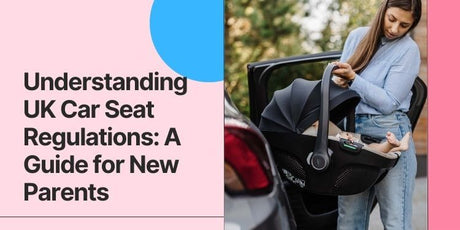Car seat laws can feel complicated, especially when you're trying to juggle everything else as a new parent. With so many different types of seats, age and weight restrictions and safety recommendations, it’s easy to feel overwhelmed. But knowing the rules is essential to keeping your child safe on the road.
This guide explains UK car seat regulations in simple terms, so you know exactly what’s required, when to move your child to the next seat and how to make sure you’re always compliant.
Why are car seat regulations important?
Car seat laws exist for one main reason – safety. In a car accident, the right car seat can reduce the risk of fatal injury by up to 70% for infants and 54% for toddlers, according to research from the Royal Society for the Prevention of Accidents (RoSPA) at rospa.com. Proper restraints protect your child’s head, neck and spine, which are especially vulnerable in a crash.

In the UK, car seat regulations are also a legal requirement. Children must use a car seat from birth until they are either 12 years old or 135cm tall, whichever comes first. If you fail to comply with these rules, you could face a fine of up to £500, as stated in the UK government’s car seat regulations at gov.uk.
The two types of car seats in the UK
There are two main types of car seats approved for use in the UK – height-based (i-Size) and weight-based seats. Each follows a different safety regulation.
Heigh-based car seats, also known as i-Size seats, comply with the ECE R129 standard. These seats are chosen based on your child’s height rather than weight, making it easier to find the right fit. Under this regulation, children must use a rear-facing seat until at least 15 months old, as rear-facing travel provides better protection for a baby’s developing neck and spine in the event of a collision.

Weight-based car seats follow the older ECE R44.04 standard. These are categorised into different groups based on weight:
- Group 0: Up to 10kg (birth to 6-9 months) – rear-facing baby seat
- Group 0+: Up to 13kg (birth to 12-15 months) – rear-facing baby seat
- Group 1: 9kg to 18kg (9 months to 4 years) – forward or rear-facing seat with a harness
- Group 2: 15kg to 25kg (4 to 6 years) – high-backed booster seat
- Group 3: 22kg to 36kg (6 to 12 years) – booster cushion
Rear-facing vs forward-facing seats
UK law allows children to move to a forward-facing car seat from 15 months old when using an i-Size seat, but many safety experts recommend keeping them rear-facing for longer. Research by the European Transport Safety Council shows that rear-facing seats provide five times more protection in frontal crashes compared to forward-facing ones.
Some extended rear-facing car seats allow children to stay rear-facing up to four years old or beyond. If you do switch to a forward-facing seat, make sure your child meets the minimum weight and height requirements, and always check that the seat is installed correctly.
Installing your car seat correctly
A car seat is only safe if it’s installed properly. Many modern vehicles come with ISOFIX anchor points, which make fitting a car seat easier and reduce the risk of installation errors. According to a study by the Transport Research Laboratory, ISOFIX seats are significantly safer than those secured with a seat belt because they are more stable in a collision.

If your car doesn’t have ISOFIX, you can still use a seat that fastens with the seat belt, but it’s crucial to follow the manufacturer’s instructions carefully. Common installation mistakes include loose harness straps, incorrect seat angles and placing a rear-facing seat in front of an active airbag. Always double-check your car’s manual to ensure your seat is fitted correctly.
The two-hour rule
It’s recommended that babies spend no more than two hours at a time in a car seat, particularly newborns and young infants. A study published by the NHS highlights that prolonged periods in a car seat could sometimes lead to breathing difficulties and reduced oxygen levels.

If you’re taking a long journey, plan regular breaks so your baby can lie flat and stretch. Some travel systems offer lie-flat car seats, which are a safer alternative for longer trips.
Exceptions to car seat laws
While UK car seat regulations are strict, there are a few exceptions where a child can legally travel without one. These exceptions are for unavoidable situations and should not be relied on regularly.
-
Taxis and minicabs – If a child car seat isn’t available, children under three can travel without a seat but must sit in the back. Children over three must use an adult seat belt if no car seat is provided.
-
Buses and coaches – Car seats aren’t required on buses or coaches, but if seat belts are available, children over three should use them.
- Unexpected journeys – If a child over three needs to travel in an emergency and there’s no car seat available, they can use an adult seat belt in the back for a short journey.
Even if the law allows it, it’s always safer to use a car seat whenever possible.
Common mistakes to avoid
Many parents unknowingly make mistakes when using a car seat. The most common ones include:
-
Using a second-hand car seat – If you don’t know its history, it may have hidden damage or may not meet current safety standards.
-
Moving to the next stage too soon – Keeping your child in their current seat for as long as possible within the weight and height limits is safest.
-
Loose harness straps – The harness should be snug, with no more than two fingers’ width between the strap and your child’s chest.
- Forgetting to adjust the seat as your child grows – Regularly check that the harness, headrest and recline position are correctly adjusted.
Staying up to date with car seat regulations
Car seat regulations change as new research emerges. To stay informed, check official sources like:
Choosing the right car seat for your child
Understanding UK car seat regulations and choosing the right seat for your child’s age, weight or height is one of the most important things you can do for their safety. Making sure it’s installed correctly and following expert advice will give you peace of mind every time you travel.
If you’re looking for a car seat that meets all UK safety standards, visit Tots on the Move. We stock a range of trusted brands to keep your little one safe and comfortable on every journey.






